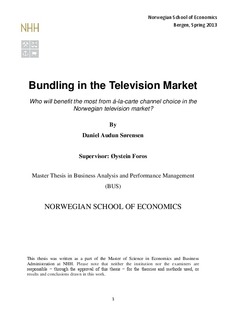Bundling in the television market : who will benefit the most from á-la-carte channel choice in the Norwegian television market?
Master thesis
Permanent lenke
http://hdl.handle.net/11250/169863Utgivelsesdato
2013Metadata
Vis full innførselSamlinger
- Master Thesis [4372]
Sammendrag
present the basic bundling models and relate the framework to the multichannel television market. These models all suggest that the á-la-carte policy would transfer surplus from firms to consumers, but I argue that these models cannot be directly applied on the television market for several reasons. Therefore I also present two more recent market specific models in order to measure the welfare outcomes of á-la-carte for the distributors, channels and consumers more accurately. I present respectively the Cullen & Crawford (2007) and the Crawford & Yurukoglu (2011) industry models. The second of these models is the most realistic and I therefore base my conclusions on this model.
The two market specific models were both tailored for the US market, and it is therefore necessary to compare the US and Norwegian markets to identify differences. I find that the markets differ to some degree both on the demand and the supply side, but I conclude that these differences are not significant. I am therefore confident that the outcome of á-la-carte in Norway would be similar to the simulation results from the US industry model.
Interestingly, I find that the consumer favored á-la-carte policy will not reduce the average household expenditure on television channels. Furthermore, the distributors and channels will be slightly better off under á-la-carte. The most important reason for these findings is the incorporation of bargaining theory in the model. Because the distributors and channels will renegotiate input costs under á-la-carte the model becomes much more dynamic.
Finally I discuss how robust these findings are on the long term, taking recent trends in the Norwegian television market into account.
